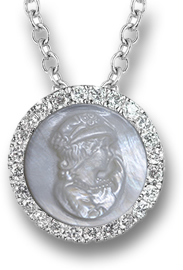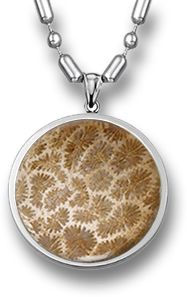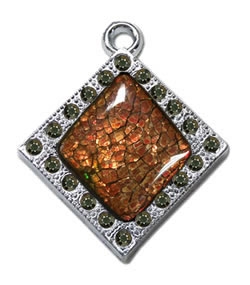|
Reviewed By Andreas Zabczyk
Buying Organic Gems and Jewelry Mother-of-Pearl Pendant
When most people hear the term 'organic', the first thing that comes to mind is usually food, such as organic fruit and vegetables. Many forget that not only can you eat and drink organic products, but you can also wear them. Although they share similar defining characteristics, in the gem and jewelry trade, 'organic' takes on a slightly different meaning than it does for the food and health industry. In order for foods to be classified as organic, they must either be grown or raised with only the use of natural materials. This means that before organic products are offered to the consumer market, they must not be processed or show any indication of artificial enhancement, including the use of synthetic chemical treatments, such as dyes used for coloring. Like organic foods, organic gemstones must also be completely natural. In fact, they are products of nature. If we apply the same definition of 'organic' to gemstones as we do for foods, then technically all untreated and natural gemstones could be described as organic. They also share two things in common: First, they're all products of some form of biological process, either animal or vegetable. Secondly, all organic gems could be considered priceless, and they're especially unique for the making of creative and interesting jewelry. What could be more precious than wearing jewelry as natural as life itself? So what exactly qualifies as an organic gem?  Men's Fossil Coral Silver Pendant
Since organic gemstones are produced by some type of biological process, either animal or vegetable, they are quite a rarity. Many organic gems are highly sought after by collectors, and some, such as ivory and coral, have caused great concern among animal rights activists and environmental campaigners. In addition to being collectable, organic gemstones are also popular for the manufacturing of jewelry. In fact, some of the earliest forms of jewelry ever found were made of the shells of marine mollusks; they would be strung and worn like contemporary beaded bracelets and necklaces. Since prehistoric times, organic gems have been prized by people from all walks of life. Some organic gemstones can be extremely expensive, but there are other varieties that are very affordable, including fossilized (petrified) wood, mother-of-pearl and shark's teeth. The family of organic gemstones is very small, and technically they're not even stones per se. Of the hundreds of gemstone varieties available today, only a small handful of gems are classified as organic, most of which are extremely rare, some even more so than rubies, sapphires, emeralds and diamonds combined. Interestingly enough, unlike organic foods, it is acceptable for organic gemstones to be enhanced by the use of artificial or synthetic counterparts. Additionally, for many gems, artificial enhancements are considered routine, comparable to the heating of sapphire or the oiling of emerald. Common organic gem enhancements for organic gems include dyeing (often seen in pearls and mother-of-pearl), as well as stabilization or impregnation, usually with plastic, polymer or resin, in efforts to increase the durability of fragile materials. Organic gems may also be enhanced through assembling of layers, which utilizes various adhesives and may even contain a layer of synthetic material (such as ammolite doublets and triplets).  Rhomboid Ammolite Pendant
Other than cultured pearls and cultured mother-of-pearl, organic gemstones must be naturally formed, which makes them especially unique. Some of the most popular and well-known organic gems include freshwater and saltwater pearls. Pearls are the ultimate in luxury, and for most of time, they were worn and owned only by the world's elite. Ivory is an organic gem that has caused much controversy over the last century. Originally the main source of ivory was elephant tusks, especially elephants from certain areas of Africa and Asia, which threatened the species. However, today, ivory can also be sourced from a variety of other, non-threatened animals such as the teeth and tusks of hippos, walruses, whales, wart hogs and even the remains of mammoths. Coral gemstones are also organic, and when polished, they can exhibit an amazing luster. Amber is another unique organic gem that has a color like no other gem in the entire world. Polished amber is normally available en cabochon and this highly remarkable material formed from the hardened resin of pine trees is a result of a process that dates back over 50 million years. As odd as it sounds, even highly polished coal is considered a desirable gem, specifically jet, one of the few types of gemstones that comes in black. Jet was extremely popular during the 19th century, but over the last century, it has become increasingly rare. Other fossilized organic materials include petrified wood; a gemstone that began its life as an organic material, but over time, became crystallized and pseudomorphed into a variety of quartz. The same process is also found in coral species. Fossil coral at one time in its life was organic living coral. But over 20 million years, it became 'agatized' and slowly transformed into quartz, all while retaining some of its original properties. Lastly, one of the most colorful organic gems in the world and arguably one of the rarest is ammolite, a gemstone that is made up of the fossilized shell remains of ammonites, primarily aragonite, which is also the very same material that is responsible for nacreous pearl. Ammolite is often cut into thin strips and carefully layered into assembled doublets and triplets because of its delicate nature. It is highly regarded for its attractive iridescence, an optical phenomenon found only a small variety of special gems. Like all things organic, there is a niche market for everything from fruit and vegetables to gems and jewelry. Living organic isn't limited to only a few aspects of life, rather, it's an entire lifestyle, involving one's health (body and mind), as well as wearables. Buying organic products can benefit us in many ways. Since by living organically, we're leaving less of an enviornmental impact, the next generation can look forward to a brighter, greener future. Online, you can find numerous suppliers and jewelry retailers who specialize in organic gems and handcrafted jewelry. Popular designs include amber rings and pendants, pearl stud earrings, and mother-of-pearl watches or cufflinks. So for those who love the organic lifestyle, Not only can you eat organic products, but you can also wear them too. This Page in Other Languages
|
| STAY IN TOUCH | NEWSLETTER |
| *You're signing up to receive GemSelect promotional email. |
Copyright © 2005-2024 GemSelect.com all rights reserved.
Reproduction (text or graphics) without the express written consent of GemSelect.com (SETT Company Ltd.) is strictly prohibited.
2646